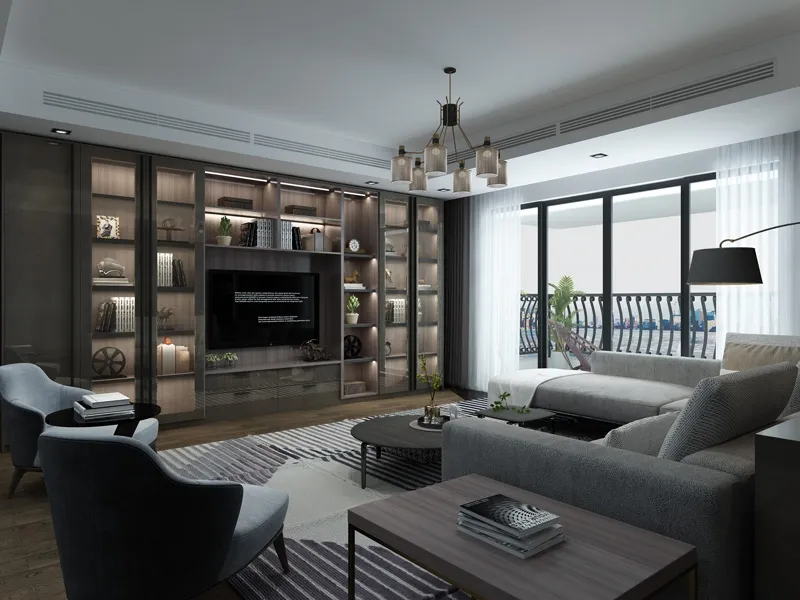
Custom TV Cabinet Material Selection Guide: Catering to Different Budgets and Styles

Choosing the right TV cabinet isn't just about hiding cables and holding your screen – it's a statement piece that defines your living space. Let's cut through the confusion and find the perfect blend of style, functionality, and value for your custom cabinet. No jargon, no sales pitches, just straight talk about what works.
The Foundation: Size Matters More Than You Think
Before we dive into materials, let's get real about proportions. That gorgeous marble-topped console? It’ll look ridiculous holding your 65-inch beast of a TV. Here's how to avoid that rookie mistake:
Quick Size Cheat Sheet
- Width: Go 3-4 inches wider than your TV (measure frame-to-frame!). For a 56" TV? Aim for a 60" cabinet minimum.
- Height: Set your eyes at the middle or slightly below center of the screen when seated. 47"-51" floor-to-top works for most.
- Depth: Need serious storage? 16-22" deep holds gaming consoles and media players comfortably.
I've seen too many living rooms ruined by a dwarfed console beneath a massive screen – don't be that person. Take five minutes with a tape measure before you even think about materials.
Material Showdown: What Actually Holds Up?
Forget flashy showroom displays – let's talk real-life durability. I've spent years seeing what materials actually survive kids, pets, and the dreaded coffee cup ring.
Solid Wood
Budget Match: Mid to High
Style Fit: Traditional, Farmhouse, Coastal
Reality Check: Oak and maple take dings but develop "character." Cherry warms beautifully with age but shows scratches. Avoid pine unless you love distress marks.
Engineered Wood
Budget Match: Low to Mid
Style Fit: Modern, Scandinavian
Reality Check: MDF with veneer won't warp like particleboard. Laminate tops handle spills well but chip if you knock edges. Not the place to cheap out – get UV-coated finishes.
WPC Wallboard (Eco Pick!)
Budget Match: Mid-Range
Style Fit: Contemporary, Eco-Conscious
Reality Check: Wood-plastic composite brings water resistance – great if you've got clumsy plant-waterers. Warp-resistant for basement setups. Texture feels warmer than laminate.
Metal Frames
Budget Match: Varies Wildly
Style Fit: Industrial, Minimalist
Reality Check: Steel legs + wood shelves = sturdy combo. Powder-coated finishes hide fingerprints. But steel alone echoes like a drum – add felt pads on shelves.
Saw a "luxury" glass console? Unless you're child-free and own stock in Windex companies, skip it. Every fingerprint and dust particle screams for attention.
Style Without the Stereotypes
Materials aren't locked to one look. You can bend the rules – here’s how actual designers pull it off:
Modern Farmhouse Without the Cheese
Materials: Weathered oak top + matte black steel legs
Why it Works: The metal keeps it sleek; the wood adds warmth. Add woven baskets – not chicken wire accents.
Luxury That Doesn't Scream "Look at Me!"
Materials: Walnut veneer with low-sheen lacquer + integrated lighting
Why it Works: Deep wood tones + subtle glow beats flashy marble. Focus on seamless joinery, not gaudy hardware.
Small-Space Solutions That Don't Suck
Materials: Floating WPC wallboard units + slim steel brackets
Why it Works: Unbroken lines visually expand space. Mount consoles 18" off floor for airy feel.
Grab a magazine pic you love. Now cross out one cliché element (barn doors, crystal knobs) and replace it with something textured and understated.
Budget Hacks That Don't Scream "Cheap"
Stop conflating "affordable" with "flimsy." You can cut costs smartly without regrets:
Under $500
- Material Focus: Thick MDF with wood-look laminate (7.5mm minimum)
- Where to Invest: Quality drawer glides – Blum Tandem runners last decades
- Where to Save: Skip fancy legs – opt for solid block bases
$500-$1500
- Material Focus: Plywood core with real wood veneer tops
- Where to Invest: UV-cured matte finish – resists scratches
- Where to Save: Simple shaker doors – intricate profiles add cost
$1500+
- Material Focus: Full hardwood construction or premium WPC
- Where to Invest: Custom cable management and LED integration
- Where to Save: Skip exotic imported woods – domestic walnut ages beautifully
True Story: A client blew $2k on "solid teak" only to find warping in humidity. Meanwhile, a $800 plywood/WPC hybrid in the same room looks flawless three years later. Material labels lie – quality construction doesn't.
Future-Proofing: Don't Build a Dinosaur
TV tech evolves faster than we can decorate. Avoid these outdated choices:
⚠️ The Massive Media Hole
Cutting a giant square for your current cable box? In 5 years it'll sit empty like a VHS slot. Instead:
Fix: Adjustable shelves with breathable backs – heat kills electronics.
⚠️ Fixed Height Compartments
That perfect PlayStation slot becomes useless when you upgrade to a chunky Xbox. Instead:
Fix: Modular cube systems like IKEA Kallax (in solid wood please!)
Smart Integration Secret:
Run a PVC conduit pipe behind cabinet backs drywall-to-baseboard. Swap cables anytime without demolition. Thank me later.
Wrap-Up: Trust Your Gut, But Verify
At the end of the day, your TV cabinet should feel like you – not a Pinterest clone. When choosing materials:
- Press samples in-store – if MDF feels hollow, it is.
- Ask for cutoffs – test stain resistance with coffee/wine.
- Check undersides – quality finishes don't skip back panels.
The perfect cabinet blends common sense with personality. Skip trends that won’t survive toddler tantrums or Netflix marathons. Pick materials that tell your story quietly but brilliantly.
Tags:
Recommend Products











